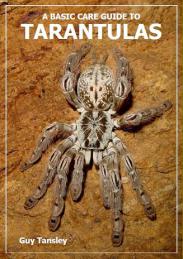
Why keep a tarantula as a pet ?
Well, the good points definitely out weight the bad. A tarantula requires little attention, doesn't need to be taken for walks, doesn't
make any noise, doesn't smell or carry any diseases communicable to man or domestic livestock. They are long lived so give many years of pleasure and fascination.
A few points have to be taken into consideration before you purchase your first tarantula -whether you want an adult, sub adult, juvenile or spiderling and is it to be an arboreal (tree dwelling) or
terrestrial (ground dwelling) species ?
There are many different tarantula species to choose from for the beginner and this section gives a description of the easier species to maintain. Arboreal species tend to be more brightly coloured
of the two but terrestrial tarantulas usually make up for their less attractive appearance with a formidable leg span. All tarantulas are cannibalistic and will definitely attack each other so they
must be either housed separately or in a securely divided tank.
Brachypelma smithi (red knee):
The abdomen is black with long reddish hairs as is the cephalothorax and tan hairs surround the carapace. The legs are also black with red and orange hairs on the "knees". This species is the one
everyone knows and wants and is now widely available as captive bred stock although its popularity may affect the price. A docile species which tolerates being handled.
Size: Up to 15 cms leg span and slow growing, maturing at around six years. Habitat: A terrestrial burrowing species from
Mexico.
Brachypelma albopilosum (curly hair):
The basic overall colouration is brown/black with light brown hairs on the legs. These hairs have a definite curl, especially on the rear legs.
Size: Up to 15 cms leg span and quite docile. Habitat: A terrestrial burrowing species from the West Indies.
Brachypelma vagans (red rump):
The colour is uniform black with long red hairs covering the abdomen and the legs have pale lines running down their length. This species has been available as captive bred stock for many years and
is one of the most attractive.
Size: Up to 15 cms leg span. Habitat: A terrestrial burrowing species from Mexico.
Grammostola rosea (Chile rose):
The basic colouration is rich brown with long reddish hairs on the legs. The carapace has a striking pink tinge. This species is very docile and considered the ideal beginners tarantula. Captive bred
stock is readily available.
Size: Up to 15 cms leg span. Habitat: Terrestrial burrowing species from Chile.
Avicularia avicularia (pink toe):
This species is very attractive having a blue/green tinge to the carapace. All the legs are covered in dense black hairs and the "toes" have a distinct pink tip. Spiderlings and juveniles of this
species are the complete opposite - having pink legs and black tipped toes.
Size: Up to 15 cms leg span. Habitat: An arboreal species from South America.
Psalmopoeus cambridgei (Trinidad chevron):
The adults are strikingly coloured with various shades of grey, olive green and brown. The legs are covered in dense hairs and there is a small rust-red patch on each toe. The abdomen has a dark
median line with five bark bands projecting off. This is an ideal first arboreal tarantula - extremely fast growing (maturing in 12 months or so) and is very hardy, able to withstand some of the
problems first encountered when beginning. Widely available as captive bred stock.
Size: Up to 15 cms leg span. Habitat: An arboreal species from Trinidad.
Whichever species you decide upon I recommend that it is purchased from a specialist breeder and supplier because this enables you of having a better chance of knowing more details about the
spider (age, sex etc.) and captive bred stock should be bought to relieve the importation of wild specimens. Check out the links section for a
list of recommended breeders in your area.
